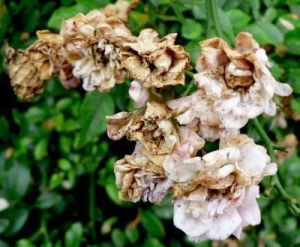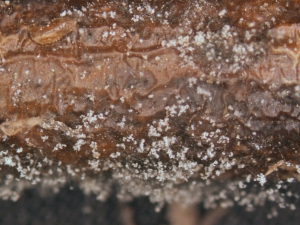Botrytis Blight of Rose
 Causal Agent
Causal Agent
The fungus Botrytis cinerea
Hosts
Rose as well as other ornamentals, fruits and vegetables. It is also known as gray mold on other crops.
Symptoms
 During periods of cool and wet weather, Botrytis blight frequently develops on roses.
The disease may affect flowers which may not open and may become covered with grayish
brown fungal growth. Sometimes the disease is observed as small flecks on infected
petals. At the base of infected flowers, sunken, grayish-black spots (lesions) may
be found on the stems and the lesions may continue down the cane. Damage is often
associated with wounds where flowers have been cut or the plants have been pruned.
These infections often result in cane blight. On cuttings taken for propagation, the
fungus may enter through cutting wounds and kill young twigs or the entire cutting.
During periods of cool and wet weather, Botrytis blight frequently develops on roses.
The disease may affect flowers which may not open and may become covered with grayish
brown fungal growth. Sometimes the disease is observed as small flecks on infected
petals. At the base of infected flowers, sunken, grayish-black spots (lesions) may
be found on the stems and the lesions may continue down the cane. Damage is often
associated with wounds where flowers have been cut or the plants have been pruned.
These infections often result in cane blight. On cuttings taken for propagation, the
fungus may enter through cutting wounds and kill young twigs or the entire cutting.
Biology of the Pathogen
 The optimum temperature for growth of the pathogen B. cinerea is 60°F. Disease development is favored by high humidity and the pathogen generally
enters the plant through wounds. The fungus forms oval, one-celled conidia (spores)
which form in a cluster. The pathogen also forms sclerotia (infectious propagules)
which appear as black, flattened or slightly raised structures on the plant surface.
The sclerotia act as the overwintering structure on infected plants.
The optimum temperature for growth of the pathogen B. cinerea is 60°F. Disease development is favored by high humidity and the pathogen generally
enters the plant through wounds. The fungus forms oval, one-celled conidia (spores)
which form in a cluster. The pathogen also forms sclerotia (infectious propagules)
which appear as black, flattened or slightly raised structures on the plant surface.
The sclerotia act as the overwintering structure on infected plants.
Control
Sanitation is an important factor in controlling Botrytis blight and all infected flowers, stems and canes should be removed and destroyed at the first evidence of symptoms. The fungus quickly produces large numbers of conidia that can be blown to uninfected plants. Plants should not be maintained in areas with high humidity. Greenhouses or propagation houses should be well ventilated and have good air circulation to promote drying.
Protective fungicides should be applied to plants that have been recently cut or pruned (wounded). Roses that are to be stored should be dipped or sprayed prior to entering storage. Fungicides should be rotated between different classes because fungicide resistance has been documented with this pathogen . Please contact your local county extension office for current information.
